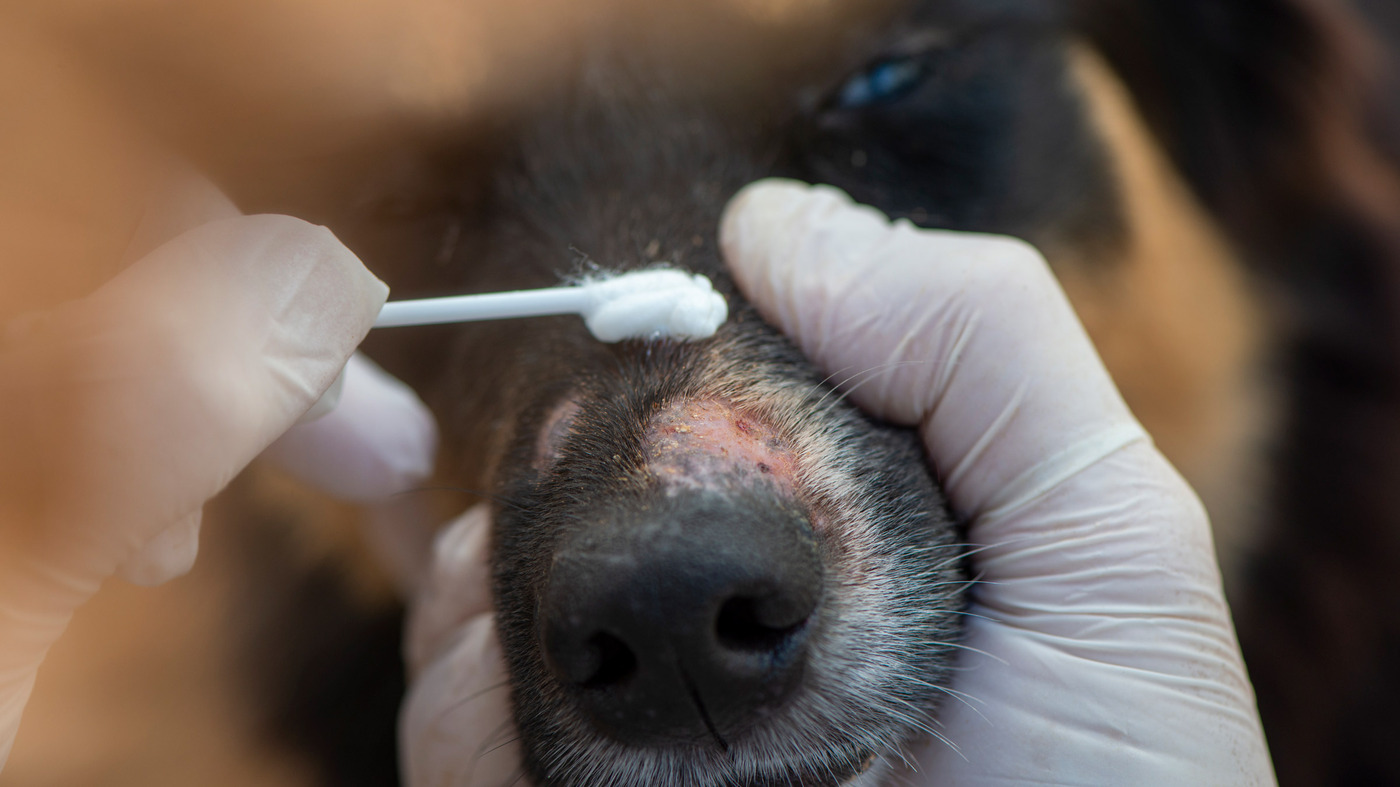Home>Health & Wellness>Common Health Issues>How To Cure Blood Parasite In Dogs


Common Health Issues
How To Cure Blood Parasite In Dogs
Modified: March 1, 2024
Learn effective ways to cure blood parasite in dogs and prevent common health issues. Find expert tips and advice to keep your pet healthy.
(Many of the links in this article redirect to a specific reviewed product. Your purchase of these products through affiliate links helps to generate commission for Pawsomeoldies.com, at no extra cost. Learn more)
Table of Contents
Introduction
Blood parasites in dogs are a concerning health issue that can have serious implications for our furry companions. These microscopic organisms, such as Babesia, Ehrlichia, and Anaplasma, can invade a dog's bloodstream, leading to a range of health problems. As responsible pet owners, it's crucial to understand the causes, symptoms, diagnosis, treatment options, and preventive measures related to blood parasites in dogs.
By gaining insight into this common health issue, we can take proactive steps to safeguard our canine friends and ensure their well-being. In the following sections, we will delve into the intricacies of blood parasites in dogs, shedding light on the symptoms, diagnosis, treatment, and prevention strategies. Understanding these aspects is essential for effectively managing and mitigating the impact of blood parasites on our beloved pets.
Understanding Blood Parasites in Dogs
Blood parasites in dogs encompass a diverse group of microorganisms that can infiltrate the bloodstream, posing a significant threat to the health and well-being of our canine companions. These parasites, including Babesia, Ehrlichia, and Anaplasma, are typically transmitted through the bites of infected ticks, mosquitoes, or other blood-feeding vectors. Once introduced into a dog's system, these microscopic invaders can wreak havoc on the body, leading to a range of adverse effects.
Babesia, for instance, is a protozoan parasite that targets red blood cells, causing anemia, weakness, and other systemic complications. Ehrlichia, another common blood parasite, can induce symptoms such as fever, lethargy, and bleeding disorders by infecting white blood cells and platelets. Similarly, Anaplasma, when present in a dog's bloodstream, can trigger fever, joint pain, and other debilitating manifestations.
Understanding the nature of these blood parasites is crucial for pet owners, as it enables them to recognize the potential risks and take proactive measures to protect their dogs. By familiarizing ourselves with the characteristics and modes of transmission of these parasites, we can implement effective preventive strategies and seek timely veterinary intervention when necessary.
Moreover, comprehending the life cycles and behaviors of blood parasites in dogs can aid in identifying potential risk factors and implementing targeted preventive measures. For instance, knowing that certain parasites are prevalent in specific geographic regions or during particular seasons empowers pet owners to tailor their preventive efforts accordingly.
In essence, gaining a comprehensive understanding of blood parasites in dogs is pivotal for safeguarding the health and vitality of our furry companions. By staying informed about the nature, transmission, and impact of these parasites, we can take proactive steps to minimize the risk of exposure and ensure the well-being of our beloved pets.
Symptoms of Blood Parasites in Dogs
Identifying the symptoms of blood parasites in dogs is crucial for timely intervention and effective management of this health issue. While the specific manifestations can vary depending on the type of parasite and the severity of the infection, there are several common symptoms that pet owners should be vigilant about.
-
Lethargy and Weakness: Dogs infected with blood parasites often exhibit signs of lethargy, weakness, and reduced activity levels. This can manifest as reluctance to engage in physical activities, decreased interest in playtime, and overall subdued behavior.
-
Pale Gums and Mucous Membranes: Anemia, a common consequence of certain blood parasites such as Babesia, can lead to pale gums and mucous membranes in affected dogs. This is a result of the parasites' impact on red blood cells, leading to reduced oxygen-carrying capacity in the bloodstream.
-
Fever and Inappetence: Many dogs with blood parasites may experience episodes of fever, accompanied by a loss of appetite. Persistent or recurrent fever, especially in conjunction with other symptoms, warrants prompt veterinary attention.
-
Weight Loss: Unexplained weight loss can be a concerning indicator of blood parasite infections in dogs. The metabolic strain imposed by these parasites can lead to a decline in body condition despite adequate nutrition.
-
Joint Pain and Lameness: Some blood parasites, such as Anaplasma, can cause joint pain and lameness in affected dogs. This can manifest as reluctance to move, stiffness, and discomfort during physical activity.
-
Bleeding Disorders: Certain blood parasites, including Ehrlichia, can disrupt the normal clotting mechanisms in a dog's body, leading to bleeding disorders. This can manifest as nosebleeds, bruising, or prolonged bleeding from minor injuries.
-
Enlarged Lymph Nodes: In some cases, dogs with blood parasite infections may develop enlarged lymph nodes, particularly in the neck and behind the knees. This can be indicative of the body's immune response to the presence of parasites.
-
Neurological Symptoms: In severe cases, blood parasite infections can lead to neurological symptoms such as seizures, disorientation, and abnormal behavior. These manifestations necessitate immediate veterinary evaluation and intervention.
Recognizing these symptoms and being attuned to any unusual changes in a dog's behavior or physical condition is essential for early detection and prompt veterinary care. If a dog exhibits any of these symptoms, especially in regions where blood parasites are prevalent, seeking veterinary attention for comprehensive evaluation and diagnostic testing is imperative. Early detection and intervention can significantly improve the prognosis and outcome for dogs affected by blood parasites.
Diagnosis of Blood Parasites in Dogs
Accurate diagnosis of blood parasites in dogs is pivotal for initiating timely and targeted treatment. Veterinary professionals employ a combination of diagnostic approaches to identify the presence of blood parasites and determine the specific type of infection affecting the canine patient.
-
Clinical Assessment: The diagnostic process often commences with a comprehensive clinical assessment of the dog's health status. This involves a thorough physical examination to evaluate vital signs, assess overall condition, and identify any visible symptoms that may indicate a potential blood parasite infection.
-
Blood Tests: Blood tests play a central role in diagnosing blood parasites in dogs. Veterinary professionals may perform various blood analyses, including complete blood count (CBC), blood smears, and serological tests to detect the presence of specific antibodies or antigens associated with common blood parasites such as Babesia, Ehrlichia, and Anaplasma.
-
Microscopic Examination: Microscopic examination of blood samples is a fundamental diagnostic tool for identifying blood parasites. By scrutinizing blood smears under a microscope, veterinary professionals can visually detect the presence of parasite organisms within the red blood cells, white blood cells, or platelets, facilitating accurate diagnosis and characterization of the infection.
-
PCR Testing: Polymerase chain reaction (PCR) testing is a highly sensitive diagnostic method used to detect the genetic material of blood parasites in a dog's bloodstream. This advanced molecular technique enables the precise identification of parasite DNA, allowing for definitive diagnosis and differentiation of various blood parasite species.
-
Vector-Borne Disease Panels: In regions where vector-borne diseases are prevalent, veterinary professionals may utilize specialized diagnostic panels designed to screen for a spectrum of blood parasites transmitted by ticks, mosquitoes, and other vectors. These comprehensive panels facilitate the simultaneous detection of multiple pathogens, aiding in the accurate diagnosis of complex infections.
-
Diagnostic Imaging: In cases where blood parasite infections have led to organ dysfunction or systemic complications, diagnostic imaging modalities such as ultrasound or radiography may be employed to assess the extent of organ involvement and guide treatment decisions.
By integrating these diagnostic modalities and leveraging their expertise, veterinary professionals can effectively identify and characterize blood parasite infections in dogs, enabling targeted treatment interventions and supportive care tailored to the specific needs of the canine patient. Timely and accurate diagnosis is instrumental in mitigating the impact of blood parasites and promoting the recovery and well-being of affected dogs.
Treatment Options for Blood Parasites in Dogs
Effective treatment of blood parasites in dogs necessitates a multifaceted approach aimed at eradicating the parasites, alleviating associated symptoms, and restoring the canine patient's health and vitality. Veterinary professionals employ various treatment modalities tailored to the specific type of blood parasite infection and the individual needs of the affected dog.
-
Antiparasitic Medications: The cornerstone of treating blood parasites in dogs involves the administration of antiparasitic medications targeted at eliminating the offending organisms. Depending on the type of parasite, specific medications such as imidocarb dipropionate, doxycycline, atovaquone, and azithromycin may be prescribed to combat Babesia, Ehrlichia, Anaplasma, and other blood parasites. These medications work by disrupting the parasites' life cycle and eradicating the infection from the dog's bloodstream.
-
Supportive Care: In cases where blood parasite infections have led to anemia, organ dysfunction, or other systemic complications, supportive care measures are crucial for aiding the dog's recovery. This may include blood transfusions to address severe anemia, intravenous fluids to maintain hydration and electrolyte balance, and nutritional support to bolster the dog's immune system and overall well-being.
-
Pain Management: Dogs experiencing discomfort, joint pain, or other painful symptoms as a result of blood parasite infections may benefit from appropriate pain management strategies. Veterinary professionals may prescribe analgesic medications or recommend supportive therapies to alleviate the dog's discomfort and improve their quality of life during the treatment process.
-
Monitoring and Follow-Up: Throughout the course of treatment, close monitoring of the dog's response to therapy is essential. This involves regular veterinary check-ups, blood tests, and diagnostic evaluations to assess the effectiveness of the treatment, monitor the dog's overall health, and make any necessary adjustments to the treatment plan.
-
Preventive Measures: Following successful treatment of blood parasites, implementing preventive measures to safeguard the dog from future infections is paramount. This may involve the use of tick and flea control products, regular veterinary examinations, and adherence to vaccination schedules to minimize the risk of vector-borne diseases.
It is important to note that the treatment approach for blood parasites in dogs may vary based on the specific parasite involved, the severity of the infection, and the dog's overall health status. Veterinary guidance and expertise are indispensable for devising a comprehensive and tailored treatment plan that addresses the unique needs of each canine patient.
By leveraging a combination of antiparasitic medications, supportive care, pain management, and vigilant monitoring, veterinary professionals strive to combat blood parasites in dogs effectively, alleviate their symptoms, and facilitate a full recovery. Timely and diligent treatment interventions play a pivotal role in mitigating the impact of blood parasites and promoting the well-being of our beloved canine companions.
Read more: What Is Blood Parasite Test For Dogs
Prevention of Blood Parasites in Dogs
Preventing blood parasites in dogs is a fundamental aspect of responsible pet ownership, aiming to safeguard the health and well-being of our beloved canine companions. Implementing proactive measures to minimize the risk of blood parasite infections involves a multifaceted approach that encompasses environmental management, parasite control, and vigilant monitoring. By integrating these preventive strategies into our canine care routines, we can significantly reduce the likelihood of blood parasite transmission and protect our dogs from potential health complications.
Tick and Flea Control
Ticks and fleas serve as common vectors for transmitting blood parasites to dogs. Therefore, implementing rigorous tick and flea control measures is pivotal for preventing these parasites from gaining a foothold in our canine companions. Utilizing veterinarian-recommended tick and flea prevention products, such as topical treatments, oral medications, and collars, can effectively mitigate the risk of vector-borne infections. Regular inspection of the dog's coat for ticks and fleas, particularly after outdoor activities, complements these preventive efforts, enabling prompt removal of any parasites before they can transmit infectious agents.
Vaccination Against Vector-Borne Diseases
In regions where specific blood parasites are prevalent, vaccination against vector-borne diseases can confer an added layer of protection for dogs. Vaccines targeting parasites such as Lyme disease, canine ehrlichiosis, and canine babesiosis can bolster the dog's immune response, reducing the susceptibility to these infections. Consulting with a veterinarian to determine the appropriate vaccination protocols based on the dog's lifestyle, geographic location, and risk factors is essential for optimizing preventive measures.
Environmental Management
Managing the dog's environment plays a pivotal role in preventing blood parasites. This includes minimizing exposure to tick-infested areas, maintaining a well-groomed and tick-free yard, and implementing landscaping practices that discourage tick and flea proliferation. Regularly mowing the lawn, removing leaf litter, and creating barriers to prevent wildlife intrusion can contribute to reducing the presence of ticks and fleas in the dog's living environment, thereby lowering the risk of parasite exposure.
Read more: How To Cure Dog Cancer Naturally
Routine Veterinary Examinations
Regular veterinary examinations are indispensable for proactive parasite prevention. Veterinarians can conduct comprehensive wellness checks, recommend appropriate parasite control products, and provide guidance on environmental management strategies tailored to the dog's specific needs. Additionally, veterinary professionals can perform diagnostic screenings for blood parasites and vector-borne diseases, enabling early detection and intervention if the dog is at risk or shows signs of potential infection.
Education and Awareness
Educating pet owners about the risks associated with blood parasites and the importance of preventive measures is crucial for fostering a proactive approach to canine health. By raising awareness about the prevalence of blood parasites, the significance of tick and flea control, and the value of vaccination, pet owners can make informed decisions to protect their dogs from potential infections. Access to reliable information and resources empowers pet owners to implement effective preventive strategies and prioritize their dog's well-being.
By integrating these preventive measures into our canine care routines, we can create a robust defense against blood parasites, minimizing the risk of infections and promoting the long-term health and vitality of our cherished canine companions. Proactive prevention is key to ensuring that our dogs can thrive in a safe and parasite-free environment, enjoying a life filled with health, happiness, and vitality.
Conclusion
In conclusion, blood parasites pose a significant health risk to dogs, necessitating a comprehensive understanding of their nature, symptoms, diagnosis, treatment, and preventive measures. These microscopic organisms, including Babesia, Ehrlichia, and Anaplasma, can infiltrate a dog's bloodstream, leading to a range of adverse effects such as anemia, weakness, fever, and joint pain. Timely recognition of the symptoms and accurate diagnosis are pivotal for initiating targeted treatment interventions and mitigating the impact of blood parasites on canine health.
The diligent efforts of veterinary professionals, coupled with proactive measures implemented by pet owners, play a pivotal role in combating blood parasites and safeguarding the well-being of dogs. Through the utilization of diagnostic tools such as blood tests, microscopic examination, and PCR testing, veterinary professionals can accurately identify blood parasite infections, enabling tailored treatment approaches and supportive care.
Treatment of blood parasites in dogs involves the administration of antiparasitic medications, supportive care measures, pain management, and vigilant monitoring to facilitate the canine patient's recovery. Additionally, preventive strategies, including tick and flea control, vaccination against vector-borne diseases, environmental management, routine veterinary examinations, and education, are instrumental in minimizing the risk of blood parasite transmission and protecting dogs from potential infections.
By integrating these multifaceted approaches into our canine care routines, we can create a robust defense against blood parasites, promoting the long-term health and vitality of our cherished canine companions. Proactive prevention and timely intervention are paramount in ensuring that dogs can thrive in a safe and parasite-free environment, enjoying a life filled with health, happiness, and vitality.
In essence, by fostering a deep understanding of blood parasites and implementing proactive measures, we can effectively mitigate the impact of these microscopic invaders, ensuring that our dogs can lead healthy, fulfilling lives free from the burden of blood parasite infections.













